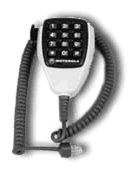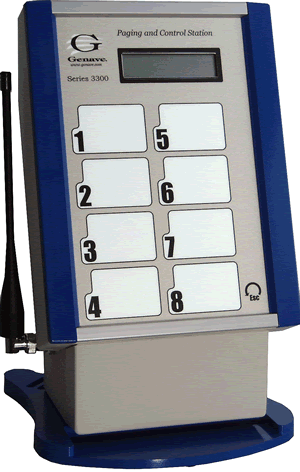DTMF Explained
DTMF stands for Dual Tone – Multi Frequency and it is the basis for your telephone system. DTMF is actually the generic term for Touch-Tone (touch-tone is a registered trademark of ATT). Your touch-tone® phone is technically a DTMF generator that produces DTMF tones as you press the buttons.
How does it work?
When you press the buttons on the keypad, a connection is made that generates two tones at the same time. A “Row” tone and a “Column” tone. These two tones identify the key you pressed to any equipment you are controlling. If the keypad is on your phone, the telephone company’s “Central Office” equipment knows what numbers you are dialing by these tones, and will switch your call accordingly. If you are using a DTMF keypad to remotely control equipment, the tones can identify what unit you want to control, as well as which unique function you want it to perform.

|
1
|
2
|
3
|
697 Hz
|
|
4
|
5
|
6
|
770 Hz
|
|
7
|
8
|
9
|
852 Hz
|
|
*
|
0
|
#
|
941 Hz
|
|
1209 Hz
|
1336 Hz
|
1477 Hz
|
When you press the digit 1 on the keypad, you generate the tones 1209 Hz and 697 Hz.
Pressing the digit 2 will generate the tones 1336 Hz and 697 Hz.
Sure, the tone 697 is the same for both digits, but it take two tones to make a digit and the decoding equipment knows the difference between the 1209 Hz that would complete the digit 1, and a 1336 Hz that completes a digit 2.
What the phone company never told you.
While the engineers were designing this protocol, they decided to throw in a few more “special purpose” tone groups. You don’t normally see these extra four buttons on telephones, but they are alive and being employed for communications signaling.
For lack of imagination, the engineers called the four extra digits “A B C D”. These all use the same row frequencies as a standard keypad, but they have an additional column tone.
|
1
|
2
|
3
|
A
|
697 Hz
|
|
4
|
5
|
6
|
B
|
770 Hz
|
|
7
|
8
|
9
|
C
|
852 Hz
|
|
*
|
0
|
#
|
D
|
941 Hz
|
|
1209 Hz
|
1336 Hz
|
1477 Hz
|
1633 Hz
|
The extra codes are very useful in preventing standard telephone codes from being used to control remote devices, and can give you override status when used correctly in a two-way radio system.
![]() Listen to a DTMF command code being send by an encoder at a standard rate. The DTMF code you hear is *00#0501#99
Listen to a DTMF command code being send by an encoder at a standard rate. The DTMF code you hear is *00#0501#99
![]() Listen to another DTMF code. This is being sent at a slower rate, but would still activate equipment watching for this code. This code is C#4D34**
Listen to another DTMF code. This is being sent at a slower rate, but would still activate equipment watching for this code. This code is C#4D34**
What are “Mark” and “Space” ?
Mark and Space refer to the duration a DTMF tone is produced, as well as the duration of the silence between individual digits.

Click here for additional information on Mark & Space timing.
Manual vs Automatic DTMF Encoders.
To send the digits quickly (40/40) you need to be using an automated encoder since you could not press each button by hand that fast. An automated encoder is also called a “Store and Forward” encoder. You “Store” the DTMF code into the device when you program it, then “Forward” it to send the entire DTMF code as one complete DTMF string of numbers and characters.


Store and forward encoders can be a programmable microphone or two-way radio, a stand-alone encoder such as the ENC-3300, or part of a large law enforcement dispatch console. In the end they all perform the same function of sending out DTMF digits and characters.
If you are sending each DTMF digit by pressing each button individually, then you are sending the code “Manually”, rather than “Automatically” with a store and forward encoder.
Click here for more details on encoders.
![]() Listen to a DTMF command code being sent from an automatic encoder at the standard Motorola rate of 250/250 (2 digits per second). The DTMF code you hear is 1646347904.
Listen to a DTMF command code being sent from an automatic encoder at the standard Motorola rate of 250/250 (2 digits per second). The DTMF code you hear is 1646347904.
![]() Listen to the same DTMF code being sent at Genave SuperFast rate of 20/20 (25 digits per second) from an automatic encoder. The DTMF code you hear is also 1646347904.
Listen to the same DTMF code being sent at Genave SuperFast rate of 20/20 (25 digits per second) from an automatic encoder. The DTMF code you hear is also 1646347904.
![]() Listen to a DTMF command code being send by an automatic encoder at a standard “Whelen” rate of 16 digits per second. The DTMF code you hear is 461####333. Standard Whelen timing is 40 msec mark / 20 msec space.
Listen to a DTMF command code being send by an automatic encoder at a standard “Whelen” rate of 16 digits per second. The DTMF code you hear is 461####333. Standard Whelen timing is 40 msec mark / 20 msec space.
![]() Listen to a Genave decoder responding to a code sent at a blazing DTMF rate of 20/5 also known as 40 digits per second. This is over twice as fast as Whelen, over three times faster than Federal Signal, and a whopping 20 times faster than Motorola. The DTMF code you hear is 1646347904.
Listen to a Genave decoder responding to a code sent at a blazing DTMF rate of 20/5 also known as 40 digits per second. This is over twice as fast as Whelen, over three times faster than Federal Signal, and a whopping 20 times faster than Motorola. The DTMF code you hear is 1646347904.
Genave decoders give you the ability to respond to DTMF codes ranging from very slow to extremely fast.
DTMF Audio Adjustments for Transmitters
Encoders with built-in transmitters normally ship with the audio levels already set.
If you are installing a DTMF encoder onto an existing radio, you can
Click Here for additional technical information on level adjustments.
What does this have to do with Two-Way Radios?
 Just as you dial your telephone to reach another person, you can use transmit DTMF signals over a radio, and turn things on and off, flash lights, control motors, cameras, activate warning systems, turn on irrigation systems, open gates, and in general control the world!
Just as you dial your telephone to reach another person, you can use transmit DTMF signals over a radio, and turn things on and off, flash lights, control motors, cameras, activate warning systems, turn on irrigation systems, open gates, and in general control the world!
You may have heard some tones at the start of some National News Broadcasts. These are DTMF tones that CBS or others like them send out at the start of the broadcast to transfer (or alert to transfer) their audio onto the local affiliates airwaves. Basically, it turns on a master switch.
Used over two-way radios, you can transmit a DTMF “phone number”. You have the same “phone number” programmed in a decoder hooked up to a radio receiver at a remote location. When the decoder sees its “phone number” come in over the radio, it wakes up and gets to work controlling the things you have hooked it up to.
But it gets even better !
With the better decoders (of course all the Genave decoders are the better ones) you are able to take phone numbers a step further.
You can use Wildcard characters in the phone number. A wildcard allows you to actually embed information in the phone number. This information is usually used to control multiple locations with one DTMF signal.
If, for instance, you use DTMF codes to open the overhead doors on your fire stations in the City. When you have a small fire, you send the DTMF code that opens only the door on fire station #1. But when you have a BIG fire, you don’t want to waste radio air-time to transmit 15 DTMF codes to open all 15 overhead doors. So you program your decoders so that, of course, each one can be controlled individually, but using a correctly placed wildcard, they will all respond to a master “Open” signal.
They can also be set up to respond to another signal for a medium size fire that opens only the doors on fire stations #1, #5 and #7.
This group, sub-group, sub-sub-group relationship is just a fraction of power and flexibility when using DTMF to remotely control equipment.
Talk-Back Systems
Of course many times you want the remote equipment to send you information. What switches are on? How much water has passed through? What is the current level? Did the door open?
When you need to receive information from the remote site, you add a transmitter and viola! You have a talk-back system.
A talk-back system (aka SCADA) sends information back to you via DTMF. This DTMF signal can light status maps, turn on indicators or supply information to computers, printers or recorders, you make the call.
DTMF is a true interactive signaling format.
Why not computer signals instead of DTMF
Radios are a particular animal. They are mostly analog and they are optimized for voice signals. DTMF was designed by the engineers to be in the normal human voice range.
What this means is that DTMF passes transparently over normal two-way radio channels, narrow-band or wide-band. It doesn’t require special channel widths, or expensive equipment. In most instances you can simply attach a cable to the speaker output of your two-way radio to a decoder, and it will be ready to go.
Its straightforward, fast, easy to understand, works on most any type of radio, and gives the most flexible features for the lowest cost!